Produktdetaljer
ISBN
9781464134227
Publisert
2014
Utgave
4. utgave
Utgiver
Macmillan Learning
Høyde
229 mm
Bredde
178 mm
Aldersnivå
Lower undergraduate, U, 05
Språk
Product language
Engelsk
Format
Product format
Heftet
Antall sider
528
